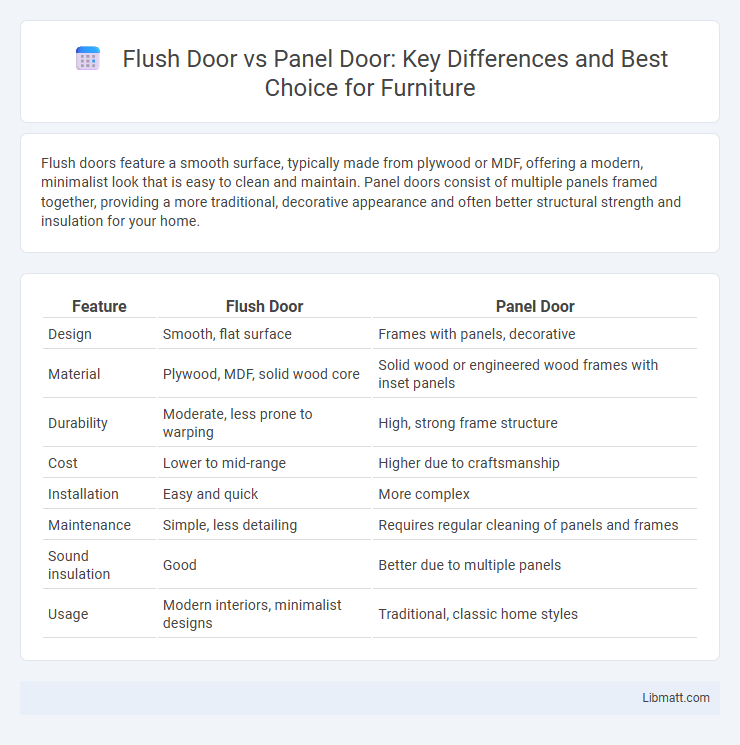Flush doors feature a smooth surface, typically made from plywood or MDF, offering a modern, minimalist look that is easy to clean and maintain. Panel doors consist of multiple panels framed together, providing a more traditional, decorative appearance and often better structural strength and insulation for your home.
Table of Comparison
| Feature | Flush Door | Panel Door |
|---|---|---|
| Design | Smooth, flat surface | Frames with panels, decorative |
| Material | Plywood, MDF, solid wood core | Solid wood or engineered wood frames with inset panels |
| Durability | Moderate, less prone to warping | High, strong frame structure |
| Cost | Lower to mid-range | Higher due to craftsmanship |
| Installation | Easy and quick | More complex |
| Maintenance | Simple, less detailing | Requires regular cleaning of panels and frames |
| Sound insulation | Good | Better due to multiple panels |
| Usage | Modern interiors, minimalist designs | Traditional, classic home styles |
Introduction to Flush Doors and Panel Doors
Flush doors feature a smooth, flat surface constructed from plywood or MDF, offering a minimalist and modern appearance ideal for contemporary interiors. Panel doors consist of framed sections with recessed or raised panels, providing classic aesthetics and enhanced structural stability through multiple components. Your choice between flush doors and panel doors depends on design preference, durability requirements, and maintenance considerations.
Key Differences Between Flush and Panel Doors
Flush doors feature a smooth, flat surface with a hollow or solid core, offering a minimalist look and excellent durability, ideal for modern interiors. Panel doors consist of multiple framed sections with raised or recessed panels, providing a classic aesthetic and greater design versatility. Your choice between flush and panel doors depends on preferences for style, insulation, and maintenance requirements.
Construction and Design Features
Flush doors feature a smooth, flat surface typically constructed with a solid or hollow core made from timber, plywood, or MDF, offering minimalist design and durability. Panel doors consist of multiple framed sections, often incorporating raised or recessed panels made from solid wood or engineered wood, enhancing aesthetic appeal and structural stability. The construction of panel doors allows for greater customization and intricate designs, while flush doors emphasize simplicity and ease of maintenance.
Aesthetic Appeal and Style Options
Flush doors offer a sleek, modern aesthetic with a smooth, uninterrupted surface ideal for minimalist interior designs. Panel doors provide versatile style options featuring raised or recessed panels that add depth and traditional charm to spaces. Customizable finishes and detailing on panel doors enable tailored looks, while flush doors emphasize simplicity and contemporary elegance.
Durability and Strength Comparison
Flush doors are constructed with a solid core or hollow core covered by plywood or MDF, offering moderate durability but less resistance to impact compared to panel doors. Panel doors feature multiple framed panels, often made from solid wood or engineered wood, providing superior strength and better resistance to warping over time. Your choice depends on the required durability and structural strength for high-traffic or exterior applications, where panel doors generally outperform flush doors.
Cost and Budget Considerations
Flush doors generally offer a more cost-effective solution due to their simpler construction and use of less expensive materials, making them ideal for budget-conscious projects. Panel doors, featuring intricate designs and solid wood or engineered materials, tend to be pricier but provide enhanced durability and aesthetic appeal. Your choice should balance initial cost savings against long-term value and style preferences.
Maintenance and Longevity
Flush doors typically require less maintenance due to their smooth, flat surface that resists dust and dirt accumulation, making cleaning easier and quicker. Panel doors, with their intricate design and recessed panels, may need more frequent upkeep to prevent dirt buildup in grooves and cracks, which can affect their longevity if neglected. Proper sealing and regular inspections can extend the lifespan of both door types, but flush doors generally offer greater durability in high-traffic or harsh environments.
Suitable Applications and Use Cases
Flush doors are ideal for modern interiors, residential rooms, and commercial spaces requiring smooth, clean surfaces and minimalist aesthetics. Panel doors are best suited for traditional homes, offices, and areas needing decorative details or enhanced acoustic insulation. Both types perform well in interior settings, but flush doors offer easier maintenance, while panel doors provide greater design versatility.
Sound and Thermal Insulation Properties
Flush doors offer moderate sound and thermal insulation due to their solid or hollow core construction, often enhanced with insulating materials like foam or composite fillers. Panel doors provide superior soundproofing and thermal resistance because of their multi-layered design with raised or recessed panels that create air pockets, improving insulation. Selecting high-quality materials and proper sealing significantly enhances the insulating performance of both door types.
Choosing the Right Door for Your Space
Flush doors offer a smooth, minimalist design ideal for modern interiors and spaces requiring uniformity, while panel doors provide classic aesthetics with raised or recessed sections that add texture and architectural interest. Your choice depends on the room's style, functional needs, and budget, as flush doors are typically more affordable and easier to maintain, whereas panel doors offer greater customization and durability. Considering factors like insulation, soundproofing, and design harmony will help you select the perfect door to enhance your space.
flush door vs panel door Infographic

 libmatt.com
libmatt.com